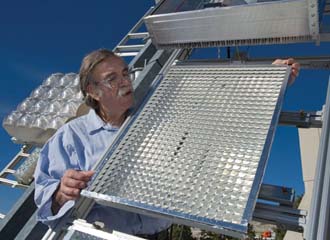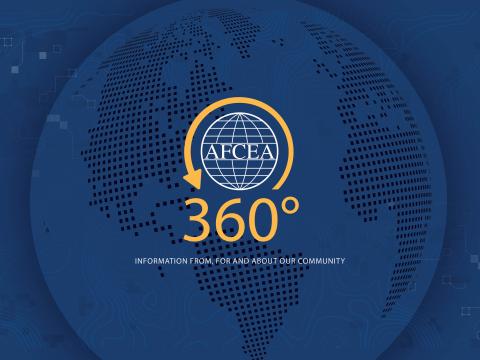Dot-Sized Solar Cell Supplies Substantial Power
 |
National Renewable Energy Laboratory (NREL) scientist Keith Emery examines a Semprius solar module at the laboratory’s Outdoor Test Facility. The NREL helped Semprius characterize and test its tiny solar cells, which have the diameter of a dot made by a ballpoint pen. |
A solar cell no bigger than the dot over the letter “i” is setting new standards for efficiency and could significantly reduce the cost of solar-provided power in hot, dry regions, making solar energy more competitive with established, conventional sources of electricity, according to experts.
Developed in part with $3 million in seed money from the U.S. Department of Energy’s National Renewable Energy Laboratory (NREL), the solar dot has proven to be a powerhouse of concentrated photovoltaic (CPV) energy. First, the NREL verified late last year that the cell converts into electricity up to 41 percent of the sunlight reflected onto it. That, according to NREL officials, is one of the highest conversion rates ever recorded. Then, in late January, two organizations in Spain verified that a solar panel made up of these minuscule cells broke world records in efficiency at 33.9 percent. Both the Instituto de Energía Solar at the Universidad Politécnica de Madrid and the Institute of Concentration Photovoltaic Systems, Puertollano, verified the panel’s efficiency rate. The previous world record was 32 percent, which means the recent achievement also marks the first time solar technology converted more than one-third of the sun’s energy into electricity. The typical conversion rate for existing technologies is about 10 to 15 percent, experts say.
“The upside of the cells being smaller is that you’re getting more power for less cost, and reducing the cost of solar energies is a huge priority for the NREL and the Department of Energy. In addition to the cells being smaller, that means the module itself is quite a bit smaller than a lot of other modules,” says Kaitlyn VanSant, the NREL’s technical monitor for the project.
The cells are developed by Semprius Incorporated, Durham, North Carolina. Company officials describe their solar dot as the world’s smallest solar cell. While holding a world record for module efficiency gives the company bragging rights, it is not really the point, they say. “It’s nice to have a record, but what we’re really trying to do is drive down the cost of electricity,” says Russ Kanjorski, Semprius vice president of business development. “That’s 100 percent of our focus. It’s just that usually the way to drive down the cost is to drive up the efficiency.”
The cell has a concentration of more than 1,100 suns, meaning it is 1,100 times smaller than the lens. The lens takes all of the light that hits it and concentrates that total amount of light onto the cell, which takes up just 0.1 percent of the module area.
Kanjorski predicts that in the coming years, CPV technology will be on par with more conventional sources of electricity. “We think we can go well below 10 cents per kilowatt hour without subsidies. The technology should support that and even lower costs as we optimize the rest of the system, not just the module,” he says.
He also points out that CPV technology is in its infancy with potential advances still to be made. “There have been some large-scale installations—in the neighborhood of 30 megawatts. And some folks have done single-digit megawatt installation, but this technology is really just starting. The fact that it’s close to being competitive with incumbent technologies so early in its development phase is another reason why the NREL and others should focus on it,” Kanjorski contends. “It’s in such early stages that there are many opportunities for additional improvements and efficiency and lowering costs and doing things smarter.”
Semprius will not rest on its 33.9 percent efficiency laurels but will continue to improve the technology in the years ahead, Kanjorski says. And seemingly small improvements can have a domino effect, leading to ever lower costs. He describes a scenario in which Semprius improves module efficiency to 38 percent. “It may not sound like much, but when you do that, tracker costs go down because you have that many more watts; the wiring costs go down; installation costs go down. It lowers the cost of the whole system.”
The company’s technology and its manufacturing process reduce costs in several ways. First, the modules can be thinner—about 2.5 inches thick compared to about 15 inches in some modules—because of the shorter focal length needed for the lenses to focus the incoming light. The Semprius module uses two lenses, the second of which is a simple bead of glass known as a ball lens. The ball lens is inexpensive but offers high performance. “Through the magic of optics, it takes the round sun and converts it so that the light comes out in the shape of a square, meaning we get a pretty uniform flux of energy on our cell,” Kanjorski explains.
He adds that the system also spreads light more uniformly and efficiently across the module, yielding higher performance, and that the small cells operate at much lower temperatures than other technologies. Lower temperatures prevent overheating, which means greater reliability and yet another method of saving costs. “What you really want is a very uniform wavelength hitting all parts of the cell. That increases the performance and the amount of electricity out of the module.”
 |
The NREL’s state-of-the-art testing and characterization instruments scrutinize the quality and efficiency of solar cells, as demonstrated on this module made by Semprius. |
Semprius uses micro-transfer printing, which was first created at the University of Illinois and intended for flexible electronics. The method includes removing and transferring the top layer of a gallium-arsenide source wafer to an inexpensive mounting substrate so that thousands of cells are processed in parallel. This allows the expensive gallium-arsenide source substrate to be used multiple times, significantly lowering the cost. Semprius estimates the technique can cut the cost of the cell by up to 50 percent.
The Department of Energy has invested $50 million since 2007 in the incubator program, funding 35 solar startups. Private investment in those firms totals $1.3 billion.
During the course of the NREL project, the Semprius improved efficiency of the module by about 10 percent. The initial project with the NREL ended in January, but Kanjorski indicates that the company may seek additional funding.
The next step for Semprius is to begin full-scale production, which officials intend to do later this year. The company broke ground last year on a 50,000-square-foot manufacturing plant in Henderson, North Carolina, and eventually expects to employ about 250 people.
The solar dot technology is intended to provide more efficient electrical utilities and not for other uses, such as solar-powered automobiles. “We’re not focused on anything with a moving application or even on rooftops. Our focus is on ground-mounted—as opposed to roof-mounted—solar, especially in the larger-scale applications, utility scale,” Kanjorski says. He envisions dozens or even hundreds of sunlight trackers in a desert environment, each with up to 400 modules potentially producing hundreds of megawatts of power. “That’s the promise of CPV, being able to lower so-called group parity costs in the right environments, which are the sunny regions like the desert Southwest of the United States, and parts of the Middle East, southern Europe, Australia,” he explains.
Semprius has partnered with Siemens Industry Incorporated, Atlanta, to co-develop demonstration systems based on Semprius’ solar module arrays and Siemens’ automation and control components. The systems are slated to be installed at numerous test sites around the world, including major utilities, commercial sites, international test locations and government facilities. Semprius has a few demonstration installations already in place, including one in Arizona with Tucson Electric. “We’ll be doing a bunch more in 2012,” Kanjorski reports.
WEB RESOURCES
National Renewable Energy Laboratory: www.nrel.gov/pv/
Semprius: http://semprius.com/index.htm




Comment
Honestly, I was a little
Comments